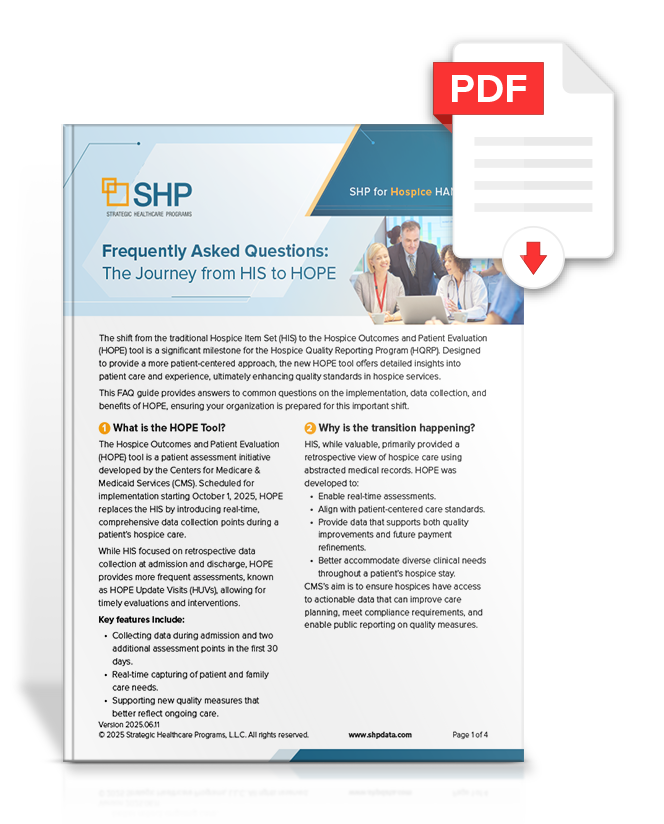
The hospice industry is preparing for a significant transformation. On October 1, 2025, the Hospice Outcomes and Patient Evaluation (HOPE) tool will replace the Hospice Item Set (HIS), a historic change in the way hospices collect and evaluate quality data. Developed by the Centers for Medicare & Medicaid Services (CMS), HOPE aims to enhance care delivery by providing a more patient-centered, outcomes-driven approach for hospice evaluation.
What does this transition mean for hospice professionals? This article takes a deep dive into HOPE's development process, the challenges it addresses, and the milestones leading to this significant shift.
Check out our HIS to HOPE Crosswalk Guide
The Transition from HIS to HOPE
What Was HIS?
The Hospice Item Set (HIS) was first introduced as part of the Hospice Quality Reporting Program (HQRP). It required providers to collect data retrospectively at two fixed points—admission and discharge—focusing mainly on care processes rather than patient outcomes. While HIS established a strong foundation for quality monitoring, its limitations became increasingly apparent.
What is HOPE?
HOPE is a patient assessment tool developed by CMS as part of the Hospice Quality Reporting (HQRP). It builds off the HIS assessment tool and is designed to collect real-time, standardized patient data during distinct timepoints and provide hospice organizations with actionable insights.
Two new assessment time points are being added called the HOPE Update Visits or (HUV). HUV 1 visits are required to be completed between days 6-15 and HUV visits between days 16-30.
HOPE also integrates new quality measures, such as timely follow-up for symptom management for pain and non-pain symptoms. The Symptom Follow Up Visit (SFV) are required within 2 days of the Admission or HUV visits if pain or non- pain symptoms are assessed as moderate or severe. Through features like standardized assessment times and updated data points this allows for better care planning.
The shift from HIS to HOPE is not merely a change in tools but a transformation in approach, enabling hospices to focus more on what truly matters—the patients and their families.
Challenges in HOPE's Development
Implementing a new system like HOPE isn’t without its challenges. Here are some of the key obstacles that CMS and providers have addressed during the transition process:
1. Comprehensive Data Collection
Unlike HIS, which relied on chart abstraction, HOPE requires providers to collect data in real-time across multiple touchpoints. This not only increases the workload for hospice staff but also demands rigorous training and adherence to new protocols.
2. Balancing Flexibility and Standardization
The new HUV touchpoints are designed to capture data within the first 30 days of hospice care. However, designing a tool that accommodates patients with varying degrees of clinical complexity while maintaining standardized procedures was a complex balancing act.
3. Stakeholder Engagement
CMS has worked closely with hospice providers and stakeholders throughout the development process to gather feedback and refine HOPE. Although this collaboration has been essential, aligning diverse needs and priorities posed challenges that required iterative solutions.
4. Integration with Hospice Workflow
Implementing HOPE necessitates changes to existing workflows, from admission processes to discharge planning. Ensuring these changes align with the Medicare Conditions of Participation (CoP) has required meticulous planning.
Final Rule Announcement
HOPE was officially finalized as part of the FY 2025 Hospice Wage Index Final Rule. The rule outlined CMS's vision for the tool and provided hospices with ample time to prepare for implementation, emphasizing training and alignment with new data collection standards.
Preparing for the Transition
Hospice providers should take advantage of the resources offered by CMS to prepare for a smooth transition to HOPE. Key steps include:
1. Reviewing the Guidance Manual
CMS has provided a robust array of resources to support hospices during this transition. These include the HOPE Guidance Manual, training videos, and webinars. These materials were created to address common implementation challenges and to ensure consistency across providers. HOPE Guidance Manual is a comprehensive resource that outlines the procedures for collecting and submitting data. Familiarize your team with this documentation as early as possible.
2. Training Your Staff
Invest in training programs to ensure your workforce is equipped to collect and submit HOPE data accurately and efficiently. CMS offers training videos and sessions tailored to different aspects of the implementation process.
3. Adapting Workflows
Assess your current workflows and identify areas that require changes to accommodate HOPE's requirements. This may include updating electronic health records (EHR) systems and revising care planning protocols.
4. Engaging Leadership
Secure buy-in from organizational leadership by demonstrating how HOPE will improve patient care and operational efficiency. Presenting a detailed implementation plan can help rally support for the necessary investments in training and technology.
Final Thoughts
The transition from HIS to HOPE signifies a monumental step forward for hospice care. By shifting from retrospective chart abstraction to real-time, patient-centered assessment, HOPE empowers providers to deliver higher-quality care while meeting the evolving needs of patients and their families.
Preparing for this transition won't be without its challenges, but the potential benefits far outweigh the initial hurdles. With proper planning and training, hospices can use HOPE not just as a compliance tool, but as a strategic asset for improving care delivery.
For hospice professionals looking to stay ahead, the time to act is now. Explore the CMS resources, begin training your teams, and position your organization as a leader in this new era of hospice care.
Get Ahead with SHP – Request Your Demo Today
Take the uncertainty out of transitioning from HIS to HOPE with SHP’s innovative solutions and expert insights. Our tools provide hospices with the actionable data needed to optimize care, ensure compliance, and thrive in this new era. Request a demo today and see how SHP can support your agency in delivering better outcomes, improving operational efficiency, and staying ahead in the changing hospice landscape. Contact us now to take the first step toward success!

